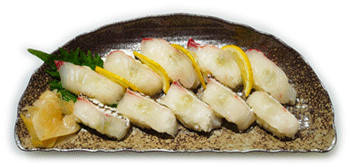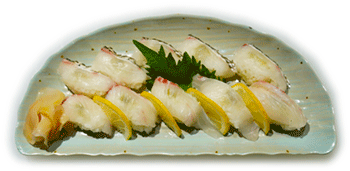| Please access the following URL if you want to secure using SSL. All pages in the site will be secure pages. |
https://secure02.blue.shared-server.net/www.fish-food.co.jp/message english 6.2024.html |
Welcome to FISH FOOD TIMES
Jun. 2024 issue No.246


Spangled emperor
13 years until three years ago
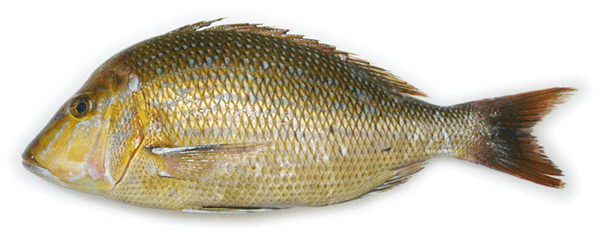
Taman, when I see this fish, I immediately think of Okinawa, and for me it is that kind of fish. The reason I feel this way is because Okinawa is filled with nostalgic and special memories, like my second home.
From April 2008 to February 2021, three years ago, I consulted the seafood department of a supermarket in Okinawa for 13 years. At the beginning of 2008, I stayed for one week, six nights and six days in a row, from Sunday evening to Saturday evening, and consulted the seafood departments of three supermarkets in Okinawa at the same time. However, the contracts with two of the companies ended after three years, and I continued to instruct the seafood department of the remaining company for two to three days a month for the next 13 years.
During the 13 years of consulting work for this company, sales in the seafood department continued to grow every year, and in fiscal 2016, nine years after consulting began, sales had increased by more than 200% compared to fiscal 2008. During this time, the number of stores only increased from 10 to 13, and the number of small stores increased by three, but sales did not double just because the number of stores doubled.
My work did not just involve consulting on the direction and thinking of the seafood department. I myself held a knife on-site and made monthly proposals to managers about product improvements and sales methods, and provided knowledge education and knife technique training to staff members, as well as sashimi technique training for part-time employees. I also believe that the multifaceted education I provided, which included a separately planned two-week consecutive training session for new employees, was also a contributing factor to the increase in sales.
The numbers listed above are intentionally not "enhanced or colored'' in any way. I would like to state categorically that these are the truths that anyone associated with the company at the time knew as a matter of course, and are not fictitious figures that I have embellished to brag. In addition, as the figures improved in this way, the proportion of the seafood department's sales in the company's total sales almost doubled during this period, greatly increasing its presence within the company, and the importance of the seafood department within the company increased.
However, in 2017, a measure called "internal reform'' that greatly influenced the direction of the company began, and the course that had been established until then was fundamentally changed. At the time, the person who was brought in from outside the company to take the lead as a representative of the president clearly did not have the ability to bring about fundamental improvements to the company. Due to his rough, power-harassment management methods that didn't treat people as people, the morale within the company fell apart, and the company began to crumble and lose its appeal as a supermarket.
To add insult to injury, the COVID-19 pandemic hit the company. As a result of the company's worsening business performance due to the COVID-19 pandemic, I no longer provided consulting services to the seafood department of this company, which I had been working for for 14 years, since March 2021.
By the way, I heard that the person who was brought in from outside the company was unable to improve the company in any positive way, and in the fall of 2022 he was removed from his position as acting president and relegated to a minor position.
Name of Taman
During the last few years of my monthly visits to Okinawa, I would usually visit for three days and three nights, including the night before. On all three nights, I would soak in awamori at my favorite izakaya, and through alcohol I was able to make new friends. Thanks to these fulfilling nighttime pastimes, I gradually fell in love with the culture and people of Okinawa.
In Okinawa, did the Okinawan people accept the product content and management methods I proposed? Not at all. Two of the three companies ended their contracts with me because the direction of the company did not match my way of thinking after three years. And only one company had strong supporters who agreed with my way of thinking, and their cooperative attitude toward me helped the seafood department to change not only the numbers but also the content for the better. However, those strong supporters could not keep up with the foolish plan of internal reforms that were being forced through by the acting president who came from outside the company, and one after another they left the company like the teeth of a comb falling off. In January 2017, the company was ranked 5th in the 2015 Kyushu Okinawa Vibrant Companies by Tokyo Shoko Research, but it has changed dramatically since then and seems to be a completely different company.
When I first started going to Okinawa in 2008, I was not completely unfamiliar with the fish of the Nansei Islands, such as Taman (Spangled emperor). At that time, there was a supermarket in Amami Oshima, Kagoshima Prefecture, where I was teaching, and around that time, I also went to Kikaijima and Tokunoshima every month as part of my job as an instructor in the seafood department, so I had a certain amount of knowledge about the fish of the Nansei Islands. Furthermore, I had always had the opportunity to teach at a supermarket in Kagoshima Prefecture in southern Kyushu, so it was not uncommon for me to come across fish from the Nansei Islands there, and I considered myself to be quite knowledgeable about "fish from the southern seas."
However, the names of fish are different in mainland Kagoshima Prefecture, the islands of the Nansei Islands, and even in relatively close areas such as Okinawa Prefecture. For example, the local name for the spangled emperor in Okinawa is Taman, but in the Kagoshima mainland it is called Tabame, in the Nansei Islands it is called Kuchibi or Tamami, and in other regions across the country it is called by a variety of other names. I have visited supermarkets in various prefectures, mainly in western Japan, to consult on their seafood departments, so I am well aware that each area has its own local name for fish. I have no qualms about the fact that spear squid is called red squid in one area and white squid in another, and have decided to adapt it to the local name.
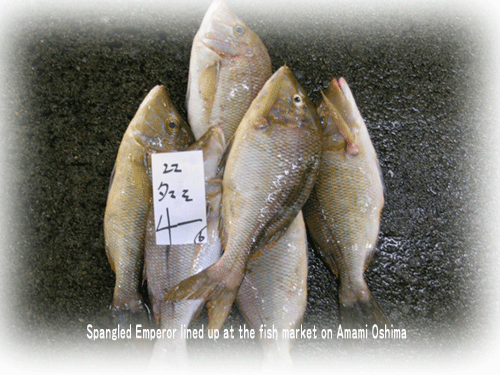
There are nearly 20 species of similar looking fish in the Lethrinus genus of the Lethrinidae family. In particular, the spangled emperor (Taman) and the Chinese emperor (Yakitaman) are so similar that I'm not sure if I could tell them apart even if they were placed side by side. It's best to call them Taman without making a distinction. Furthermore, I have to confess now that I don't actually have enough knowledge to distinguish between similar-looking fish in Okinawa by their local names.
For me, Taman(spangled emperor) is one of the most impressive fish in Okinawa, along with Irabuchi, Machi, and Mibai. Research into seedling production of spangled emperor (Taman) began in 1976 at the Yaeyama Branch of the Okinawa Prefectural Fisheries Experimental Station (currently the Ishigaki Branch of the Okinawa Prefectural Fisheries and Marine Technology Center), and in 1979 they succeeded in producing the world's first seedlings. For a long time, spangled emperor (Taman) has been produced as a seedling species for release and aquaculture, and it is one of Okinawa's representative fish that can be seen steadily in fish stores.
Representative fish of Okinawa include Akajin (Leopard coralgrouper), Akamachi (longtailed red snapper), and Makubu (Blackspot tuskfish), but I personally see Taman, along with Irabuchi and Mibai, as representative fish of Okinawa. Although I have handled the spangled emperor many times in the field, I have never had the opportunity to write an article about it for FISH FOOD TIMES, and I have always wanted to write about it. Now that the opportunity has finally come, I would like to write about everything I know about the spangled emperor.
Spangled Emperor's Cuisine
As mentioned above, the spangled emperor is also called Kuchibi in some parts of the Nansei Islands, and Kuchibi seems to be derived from the word "beautiful mouth." In fact, the inside of its mouth is a bright orange color, as shown in the image below, so it could be said that its mouth is beautiful. (Just to be clear, the white stick in the mouth of the image below is a toothpick used to support the mouth when it is open for the photo.)
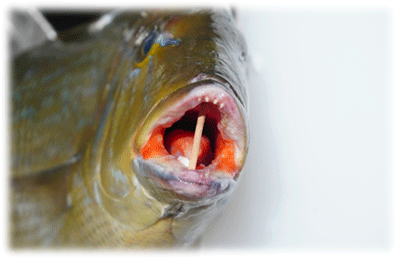
I ate the 3.1kg spangled emperor I purchased in four different dishes: sashimi, sushi, meuniere, and simmered head, which I would like to introduce below.
First, there is the process of preparing fillets for simmered head. The spangled emperor has a large face with protruding lips, and it would be a waste to simply use it as fish bones for next to nothing, so the edible parts are left larger to increase the value and create voluminous fillets for simmered Head .
| Spangled Emperor's fillets for simmered head production process | |
|---|---|
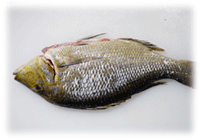 |
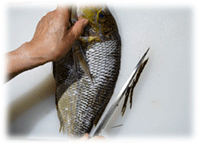 |
| 1,A spangled emperor with relatively large scales removed, gills and internal organs removed. | 6,Cut off the dorsal fin with the base of a knife. |
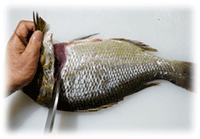 |
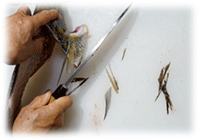 |
| 2,With the intention of using it for sashimi and sushi, a notch is made between the head and body up to the central bone. | 7,Cut off and remove all fins including pectoral, pelvic and anal fins. |
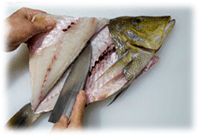 |
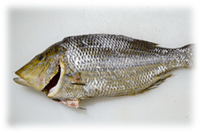 |
| 3,Cut from the edge of the anal fin on the lower body, past the central bone, and all the way to the edge of the dorsal fin. | 8,A state of after trimming. |
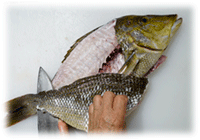 |
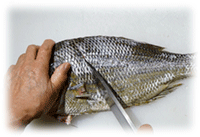 |
| 4,Without switching the fish body from front to back, cut open from the dorsal fin to the caudal fin. | 9,To avoid cooking boiled fish ara, cut the fish so that more of the edible part remains, rather than leaving only the collar of the fish on the head. |
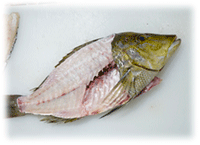 |
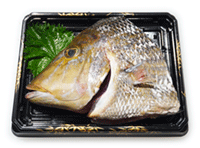 |
| 5,A state in which only the lower body is separated, with the head still attached. | 10,Fillets for simmered head are cut to a balanced size so that the edible portion is large and noticeable. |
The spangled emperor fish weighed 3kg, and the head was also large, so I felt that if I cut it into fillets for simmered head with a large, edible portion, it would be large and voluminous, and I would be able to appeal to customers who like stewed fish. I actually tried making boiled fish from this, but the head was so thick that I had trouble choosing the depth of the pot, and even if I used a fairly large amount of fish stock, it still felt insufficient, so I boiled the fish stock with a ladle. I ended up using the ladle to stock the fish a lot more often.
| Spangled Emperor's Simmered Head Cooking Process | |
|---|---|
 |
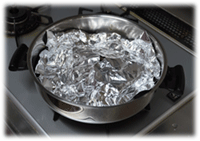 |
| 1,Add burdock root cut into 3cm lengths and sliced ginger to the boiling stock. | 3,Cover with a drop lid and simmer for a while. |
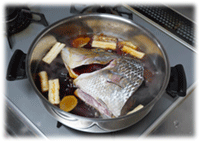 |
 |
| 2,Put a large amount of fish stock in a deep pot and add a large fish head into it. | 4,Since the fish stock does not reach the surface of the head, you have to repeatedly scoop up the fish stock with a ladle and pour it on again and again. |
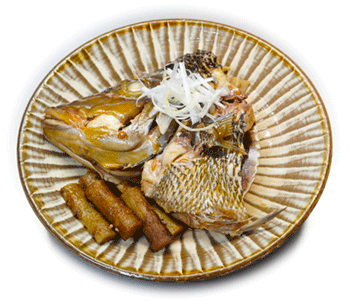 |
|
| 5,Spangled emperor's simmered head with a lot of edible parts | |
Next, I will commercialize the upper body with the central bone that remains after making the fillets for the simmered head. In order to increase the value of the simmered head fillet, more edible parts were reserved for the head, which resulted in a half-finished upper body. However, since the fish is large, it is calculated that there will be two fillets for meuniere without any problems.
| Meuniere fillet work process for spangled emperor | |
|---|---|
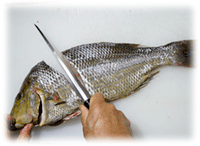 |
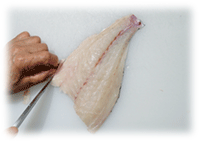 |
| 1,Separate the fillets for simmered head. | 6,Remove the belly bone from the upper body. |
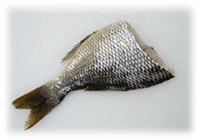 |
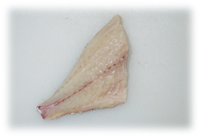 |
| 2,It is an awkward size for an upper body with a central bone but no head. | 7,As for the upper body, it has a slightly short shape. |
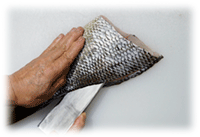 |
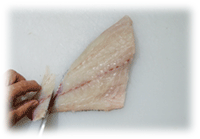 |
| 3,Make a notch at the dorsal fin and continue towards the backbone. | 8,To create fillets for meuniere, trim and shape the tail end. |
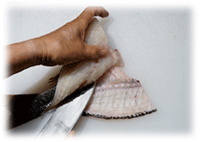 |
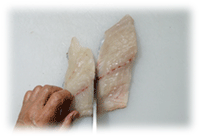 |
| 4,Cut past the backbone and towards the anal fin. | 9,Divide it into two parts so that they are as equally sized as possible. |
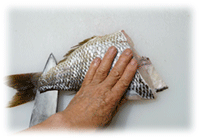 |
.gif) |
| 5,Cut open the edge of the anal fin, proceed towards the tail fin, and separate the upper body. | 10,Fillet products for spangled emperor meuniere are completed. |
The white-fleshed spangled emperor is a versatile fish that can be used in any type of dish. This time, I chose to make a meuniere without going too crazy, but when I ate it, the skin was a nice accent and it was delicious, so I made the right choice to make this meuniere dish.
| Spangled emperor Meuniere Cooking Process | |
|---|---|
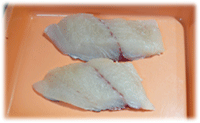 |
 |
| 1、Sprinkle fillets with salt and pepper. | 4,Place fillets in frying pan. |
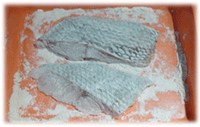 |
 |
| 2,Coat the entire surface of the fillet with flour. | 5,The large Spangled Emperor has thick flesh, so cover it with a lid to ensure that it cooks all the way to the core. |
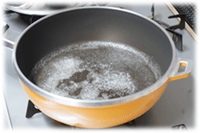 |
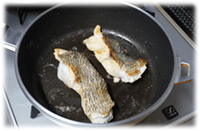 |
| 3,Melt the butter in a frying pan. | 6,Bake until the skin is nicely coloured. |
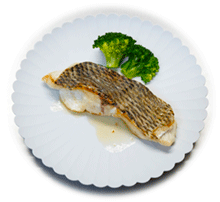 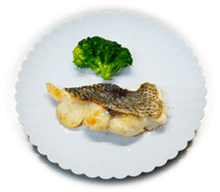 |
|
| 7,Finish by pouring butter containing the extract from the fish body on top. | |
Spangled Emperor's Sashimi and Sushi
Now, the next step is to make sashimi and sushi using the lower body. Since it was a large white fish weighing 3 kg, I consciously tried to cut it delicately and carefully.
| Spangled emperor's sashimi and sushi work process | |
|---|---|
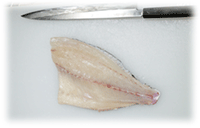 |
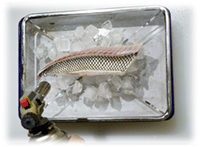 |
| 1,Lower body with the skin still attached. | 7,The belly body does searing. |
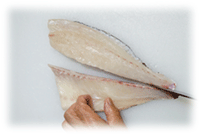 |
 |
| 2,Leave the chiai bone on the belly body, and separate the back body and belly body. | 8,The state after finishing the searing work using the burner. |
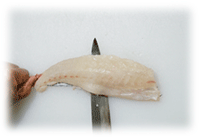 |
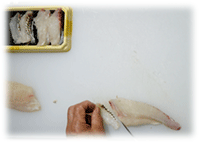 |
| 3,Remove the skin from the back using the sotobiki technique. | 9,Cool the seared belly body thoroughly and cut off the required amount of sushi dane. |
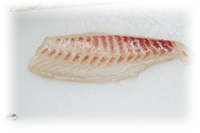 |
 |
| 4,Back body with skin removed. | 10,Make sogitsukuri sashimi from the back body without skin. |
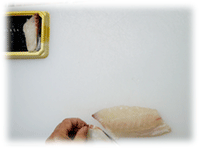 |
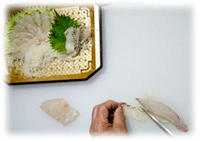 |
| 5,Cut the back body and make it into sushi dane. | 11,Make sogitsukuri sashimi from the grilled belly body and place on a plate. |
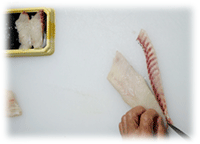 |
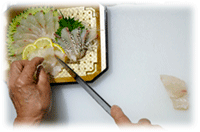 |
| 6,Once you have secured the required amount of sushi dane from the back body, remove the chiai bone from the belly body. | 12,Finally, the sashimi is finished by appropriately distributing the amount of sashimi ingredients. |
|
|
| Spangled emperoe sushi | |
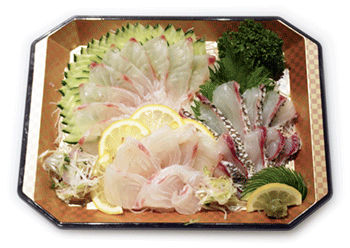 |
|
| Spangled emperor sashimi | |
Assortment of raw fish such as Spangled Emperor
With this, I used almost all of the 3.1kg spangled emperor fish, excluding the internal organs, central bone, and fins. When these are completed and served on the table, they are truly luxurious. It was too much for a couple to eat, but I felt it was enough to feed three to four people.
The spangled emperor fish is not a rare fish that is rarely found. Since there are a fair number of wild fish, it is a popular fish among anglers, and as mentioned above, seedlings are produced, released, and cultivated in Okinawa, so it is a relatively easy fish to obtain if you are interested.
However, even if you hope to find this fish called spangled emperor in a whole fish in the fish section of a supermarket, the chances are almost zero. You may be able to find this fish at a fish specialty store that has a good reputation for having a good selection. However, if this fish were to arrive at a fish specialty store, the person in charge would immediately call their customers, such as izakayas and restaurants, to try to sell it to them. Unfortunately, this trend is becoming stronger, and the assortment of fresh whole fish in the fish sections of supermarkets is gradually declining, to the point where the fish sections of supermarkets are now more like sections of farmed, frozen, and salted and dried fish, which is undeniable.
As for how I got my hands on this spangled emperor, it was at the fish counter of my usual supermarket, which always makes me feel hopeful that some interesting raw fish might be in stock. The selection of raw fish in this fish section must be one of the best in Kyushu, and the author believes that there are few other supermarket fish sections in the whole country that offer such a wide selection of raw fish. I don't know the exact figures for the fish section, but I have been consulting for the company's seafood department for about five years, so when I go to the store to buy fish and talk to the fish section manager, I can guess the approximate figures. Considering the size of such a small store, the store's fish department boasts an impressively large sales volume that outsiders would hardly imagine.
This fish store is valued by small-scale business people who want to use fish as cooking ingredients, but don't need the amount that they would have to go to the fish market to purchase. They can purchase the amount of raw fish they need by the fish alone from a wide selection, and cooking of fishs is done comfortably and quickly, so the restaurant has many customers who drive for over an hour just to come here.
It takes me more than an hour to get to the store from my home, but when I visit, not only the head of the seafood department but also everyone I once knew, even now that we no longer have a working relationship, still call out to me, "Teacher, Teacher..." and treat me really well. It is no exaggeration to say that it is thanks to this fish section and all of you that FISH FOOD TIMES has been able to continue to this day, and for that I am truly grateful, but I also feel guilty that I have not been able to fully convey this to everyone.
I'm not the only one who relies on this store, and I'm sure many customers feel the same way even if they don't say it out loud. The reason is that it's not easy to find another store with such a great selection of raw fish as this store these days, and it's almost impossible to find one in the area.
I believe that this troubling reality regarding the purchase of fish is actually a hidden need that has not yet surfaced, but unfortunately, most supermarket presidents and other managers do not understand this. There seems to be a widespread prejudice in the supermarket industry that fish is no longer a popular product compared to the past. However, even though this is the result of their own wrong policies, evasion, and neglect, they are shifting the blame to the general excuse that people are moving away from fish.
It's not that the seafood departments of supermarkets are not profitable, but rather that instead of trying to seriously create an attractive fish section, they cut corners by simply running a half-hearted fish section that has no distinctive features and does not differentiate itself. In other words, customers are fed up with supermarket fish sections. Customers who are true fish lovers are increasingly going to stores that have fish sections with a full range of products, such as the store mentioned above, and half-hearted, unattractive fish sections are losing more and more sales.
In the future, we will live in a world where seriousness will be questioned even more, and the trend of winners and losers will become stronger, and half-hearted fish stores will be weeded out. We want our fish counter to have a presence that makes customers think, "If this store goes away, I'll be really in trouble, so I'll do my best to support this store.''
| Please access the following URL if you want to secure using SSL. All pages in the site will be secure pages. |
https://secure02.blue.shared-server.net/www.fish-food.co.jp/message english 6.2024.html |
An opinion and the communication are to iinfo@fish food times
Date of updating 1 Jun. 2024

